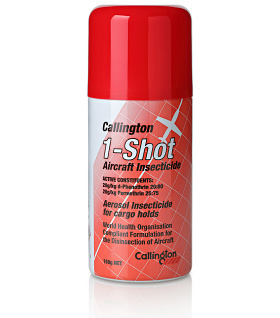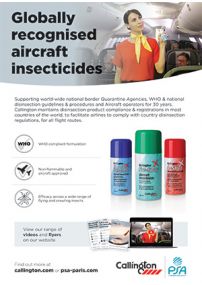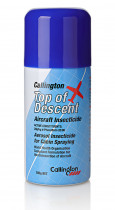Aviation Products // Aircraft Insecticides
- Tested and approved to Boeing, Douglas & AMS Specifications
- Complies with Airbus CML 14-010B
- NATO Stock Number: 6840-66-131-2263
- CAGE Code: Z5104
- Non-flammable aircraft insecticide
- Disinsection of Cargo Holds
- Overnight insect treatment
- Packaging: 12 x 150-gram cans per carton
Description
Callington 1-Shot is a non-flammable aircraft approved aerosol insecticide for use inside the aircraft cargo holds prior to departure. This product is used to prevent the spread of vector-borne diseases, such as Dengue Fever, Yellow Fever, Malaria, Chikungunya, and Zika. It is also effective against a range of agricultural pests, which present a biosecurity risk.
Approvals
Callington 1-Shot complies with the World Health Organisation specifications for aircraft insecticides and has the following approvals.
- Boeing D6-7127 and AMS 1450
- Referenced on the Airbus Consumables List: CML 11ABB2
- NATO Stock Number: 6840-66-131-2263
- CAGE Code: Z5104
- In compliance with IATA Medical manual & ICAO Annex 9
- Complies with Ministries of Health & Agriculture, globally
- Callington is an ISO 9001:2015 quality accredited company
Application
Callington 1-Shot Aircraft Insecticde is to be used for cargo hold disinsection at the last port prior to departure or on-arrival.
Treatment Procedure
TREATMENT PROCEDURE PRE-DEPARTURE
• Treatment must be carried out after all cargo has been loaded, and just before the hold door is closed.
• Since aerosols may set off smoke alarms, be sure to advise the crew that hold spraying is about to commence.
• During disinsection and for 5 min after completion of spraying, the aircraft’s air-conditioning must remain off. Recirculation fans may be left on if essential for operation of the aircraft but should be set to the lowest rate.
• Aerosols must be discharged into each cargo hold in such a manner as to ensure that all parts of the cargo hold have been disinsected.
• As the cargo hold door is being closed, leave just enough of an opening to stand the aerosol(s) 1-Shot between the cargo containers.
• Hold the nozzle down to activate the aerosol.
• If more than one can is required, repeat this application method with additional cans.
• When you see that the spray has been activated, close the hold door immediately, leaving the cans in place to complete the disinsection process.
• Once the aircraft has reached its destination, the exhausted cans are to be collected by ground handlers.
• Spraying of holds shall be carried out at a rate of *140g/100m3.
*See note below on updates to Cargo spray rates from WHO.
TREATMENT PROCEDURE ON-ARRIVAL
• Since aerosols may set off smoke alarms, be sure to advise the crew that hold spraying is about to commence.
• During disinsection and for 5 min after completion of spraying, the aircraft’s air-conditioning must remain off. Recirculation fans may be left on if essential for operation of the aircraft but should be set to the lowest rate.
• Aerosols must be discharged into each cargo hold in such a manner as to ensure that all parts of the cargo hold have been disinsected.
• Disinsection may be done manually by directing the spray into small pressure hatches where present or by placing aerosols inside the hold.
• Open the hold door by no more than 30cm, place the aerosols inside the hold in a secure upright position and activate the lock-down nozzle(s).
• Once the spray aerosol(s) appear to be functioning correctly, immediately close the hold door to complete disinsection.
• Allow 2 min for the aerosols to fully discharge and then wait a further 5 min for saturation.
• Spraying of holds shall be carried out at a rate of *140g/100m3.
*See note below on updates to Cargo spray rates from WHO.
*Application rate as per WHO recommendations (2nd Edition – Nov.2023):
• Forward Hold and Aft Hold of commercial passenger or freighter aircraft: 140g /100m³.
• Main Deck Cargo of a freighter aircraft: 55g /100 m³.
• No change to Cabin volume: 35g /100 m³
Verification
The applicator is responsible for ensuring that a certificate detailing the hold treatment is completed. For compliance purposes, the applicator must record the product serial number, located on the underside of the can. The certificate for the hold disinsection and the exhausted or partly exhausted cans must be carried onboard the aircraft and made available to an officer/inspector on request upon arrival.
Ordering Info
| Item Code | Size | Units per carton |
| 4508/150 | 150g | 12 |





